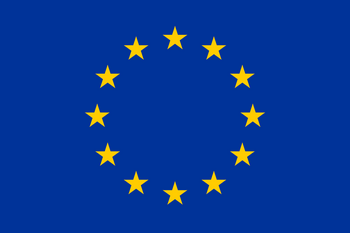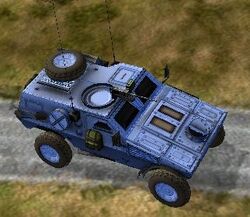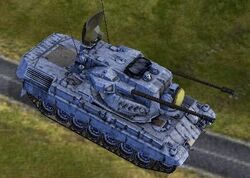The European Union is a faction in Shattered Union. It is one of two non-American factions in the game, and the only one that is playable in the campaign- the other is Russia, which is playable in the multiplayer. The European Union is the only faction with the explicitly-stated goal of restoring the United States, though the only way it can do this is through the use of military force. The EU does not field a single one of the units used by the other factions, apart from basic common units like single-use units and infantry.

The flag of the European Union.
In-game description:
"The European Union peacekeeping force currently resides in a single territory made up of the former states of Maryland, Delaware and parts of Virginia, West Virginia, Pennsylvania, and New Jersey. After open hostilities broke out, the war compounded the growing instability in the world due to the loss of such a large and prolific market. The EU voted to re-establish the union of states to prevent the spreading chaos. American resentment has grown since the EU decided to expand its role in the war."
History[]
The European Union traces its beginnings to the Treaty of Rome in 1958. Belgium, France, West Germany, Italy, Luxembourg, and the Netherlands were the founding members. Since then, numerous other nations have joined, including East Germany by default when it reunified with the West in 1990. The European Union had 28 members by 2013, the most recent to join being Croatia.
The European Union was alarmed at the events taking place during David Jefferson Adams' presidency. The threat of losing the United States was a fearsome one, promising to destabilize the rest of the world politically and economically. After a low-yield nuclear weapon detonated at ground level destroyed Washington, D.C. on 20 January 2013, it was obvious that events had completely spiraled out of control.
Concerned with securing international interests, the EU's member states held an emergency vote on whether to send a peacekeeping force to North America to restore the United States. After the vote passed, EU peacekeepers crossed the Atlantic Ocean and occupied the ruins of Washington D.C. and surrounding land in the former states of Virginia, Maryland, Delaware, West Virginia, and Pennsylvania. EU helicopters and trucks reached central Washington, D.C. on 28 January 2013.
Left with no choice but to forcibly put an end to the chaos and re-establish the United States on their own, the European Union's peacekeepers began the process of trying to defeat the other six factions. Though the initial landings had taken a considerable amount of the territory surrounding Washington, it paled in comparison to the land held by the other factions in the Second American Civil War. The European Union's effort was seen as an unwelcome intrusion by many former American citizens, and with only one territory to begin their campaign in North America with, the peacekeepers' position was already becoming precarious when the war formally began in 2014.
Territory[]
The European Union starts off with a single territory, the Eastern Shenandoah. It borders New England's New York and Ohio Valley to the north and east respectively, and The Confederacy's Carolinas to the south.

EU tanks and infantry under fire from Apache helicopters.
Units[]
The European Union has come a long way from its home territory and the member nations that have contributed have sent some of Europe's most advanced military technology. Apart from basic common units like infantry, commandos, and single-use units, the EU's forces are all unique from those of the American factions. From the origins and users of the units sent and available to the peacekeepers in the former United States, the United Kingdom, France, Germany, Spain, the Netherlands, Italy, Slovakia, and Poland are all potential or definite contributors. The European Union's available units are:
- Single-Use Units: EU Bunker, Air Defence Tower, FH 105, FH 155, Peacekeepers
- Infantry: EU Heavy Infantry, EU Commandos, Sappers
- Light Armor: VBL 1, Pandur, Marder
- Medium Armor: AMX 30, Vextra
- Heavy Armor: Challenger 1, Leopard 2, EU Goliath
- Anti-Air: Gepard, Tridon
- Artillery: PzH 2000, Zuzana
- Helicopter: Mangusta, Tiger
- Fighter: Tornado, Typhoon
- Bomber: LA4 Nimrod
- Other: Airfield
Special Powers[]
- Neutral: Corrosive, Protanites, Hold the Line, Rally
- Positive: Eulogy of Freedom, Cyborg Soldiers, Hold the Line, Nanotechnology, Glory
- Negative:
Gallery[]
Behind the Scenes[]
- The European Union is the only faction in-game to not actually be a single entity, but a union of more than two dozen sovereign states voluntarily cooperating on political, economic, civil and military matters.
- Despite sharing the goal of restoring the Union, the NEA and the EU cannot form an alliance or even create a truce with each other.
- Germany is the largest contributor to the EU force, or at least German-designed and built units are. The Leopard 2, Gepard, PzH 2000, Marder and Tiger are all German in origin and are primarily operated by the German military.
- Despite the fact that several European Union members fielded the M270 MLRS (known in-game as the MERL), including France, Germany and the United Kingdom, the MERL is nonetheless unavailable to the EU faction in the campaign and multiplayer.
- By 2005, not one of the European Union member states' air forces had a strategic bomber in their inventory. The last was the Avro Vulcan, retired by the Royal Air Force in 1984. The featured bomber of the EU in-game, the LA4 Nimrod, is not at all designed or intended for the role it is shown being quite good at in-game. The Hawker-Siddeley Nimrod served exclusively in the RAF as a maritime patrol and airborne early warning aircraft until its retirement in 2011. Most likely, the game developers found the EU had no aircraft able to parallel the Stealth Bomber or the Bear, and just appropriated an aircraft that looked suitable for the role.
- It is strange that the Challenger 1 is available to the EU forces, but not the Challenger 2, considering the latter replaced the former in the 1990s and the British Army would not have left its modern tanks at home if contributing at all to such an important peacekeeping force as the one going to North America.
- Which nation designed the EU Goliath is unknown. It was most likely jointly developed, as this has been done before on defense programs and projects in the EU, such as with the Eurofighter Typhoon and the Panavia Tornado.






